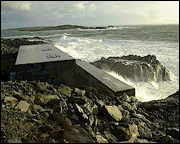Hello Umbra,
I just read a little bit about wave power and was wondering what you think the future potential is for this clean and never-ending energy source?
Peter Blomquist
Orlando, Fla.
Dearest Peter,
Wow. I’m a sucker for anything with a good name, like “LIMPET.” There are fun technologies under development to harness the might of the sea as it swells up from the briny deep.

Crest easy.
Photo: iStockphoto
Wind hits the surface of the ocean and makes tiny ripples that over distance and time become waves. As contrasted with the tidal technologies we discussed last week, which use the tidal cycles to trap and release water, wave devices use the constant sloshing and swelling of the ocean to generate energy. Wave power technologies come in three broad categories: on shore, near shore, and offshore. And then three more categories: Buoyant Moored Device, Hinged Contour Device, and Oscillating Water Column. I’ll give you just a few examples out of the truckloads I found.
Islay, Scotland, has an Oscillating Water Column called the LIMPET (an acronym), a 500 kW onshore wave-power generator. The LIMPET is a concrete bunker on the beach with a large central cavity, into which waves slosh. As water rises and falls within the cavity it displaces air, which exits and returns via a turbine-clogged tunnel. The spinning turbine is attached to a generator that, among other things, powers a Scottish bus — here is a site with an animated show for you.
Offshore devices, in depths above 80 feet, include a long, segmented tube called the Pelamis, after a type of sea snake. The wave-induced gyrations of this Hinged Contour Device drive hydraulic pistons that send electricity to shore through cables on the sea floor. Then you have Buoyant Moored Devices, which look like signal buoys, with a central piston sloshing up and down as the sea swells; this mechanical stroking is connected to a generator as well. A wave farm would be a conglomerate area with several devices, much like a wind farm.

LIMPET in Islay, Scotland.
I read only promising information about wave power’s capacities. A lot of development is occurring in Europe, where public enthusiasm and government commitment to renewables means funding and research support. Additionally, Western Europe happens to have bountiful wave-rich sites. Wave power is most promising around 40 to 60 degrees of latitude in both the Southern and Northern Hemispheres (there’s a map here), particularly on the west coasts of Britain and the United States. I’ve seen one estimate that wave power could contribute 1 to 10 terawatts of energy worldwide — the U.S. uses about 3 to 4 TW annually, and the world about 13 TW.
Interesting design problems with wave power include the destructive power of the salty sea — corrosion and weather and storms and all. Benefits include the relative constancy of power availability, as contrasted with wind and tidal barrages. I’m running out of room, so I’ll just say that one last drawback to wave power is that the near-shore ocean is now considered a recreational site full of beauty, not a working area, and so wave farms may meet the same resistance that has met many a wind farm. I eagerly await your letters on the subject.
Goodbyely,
Umbra



